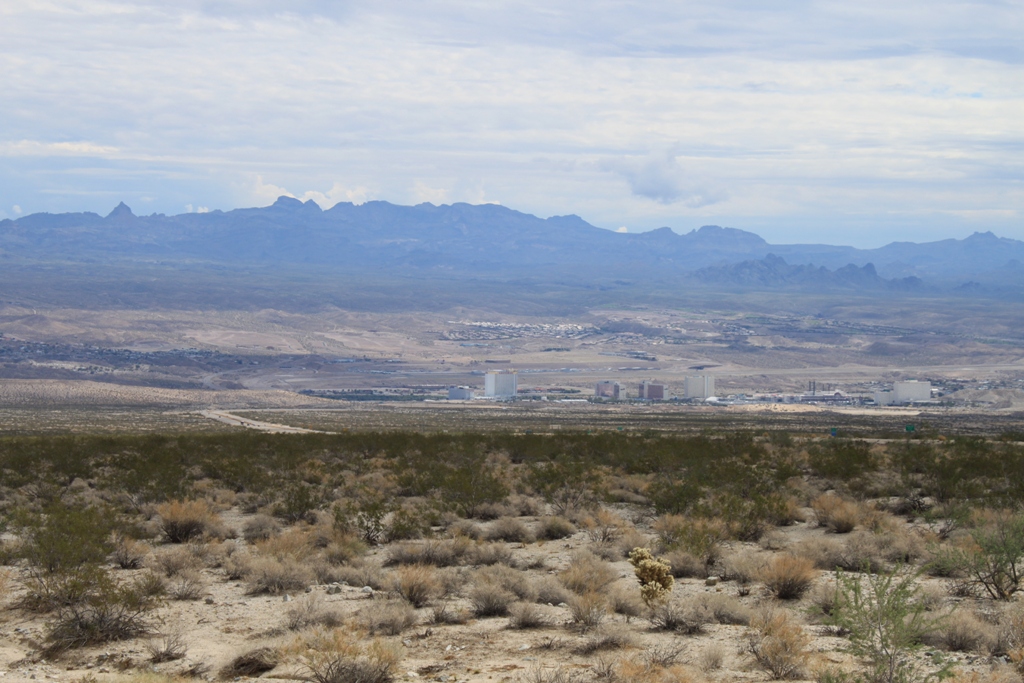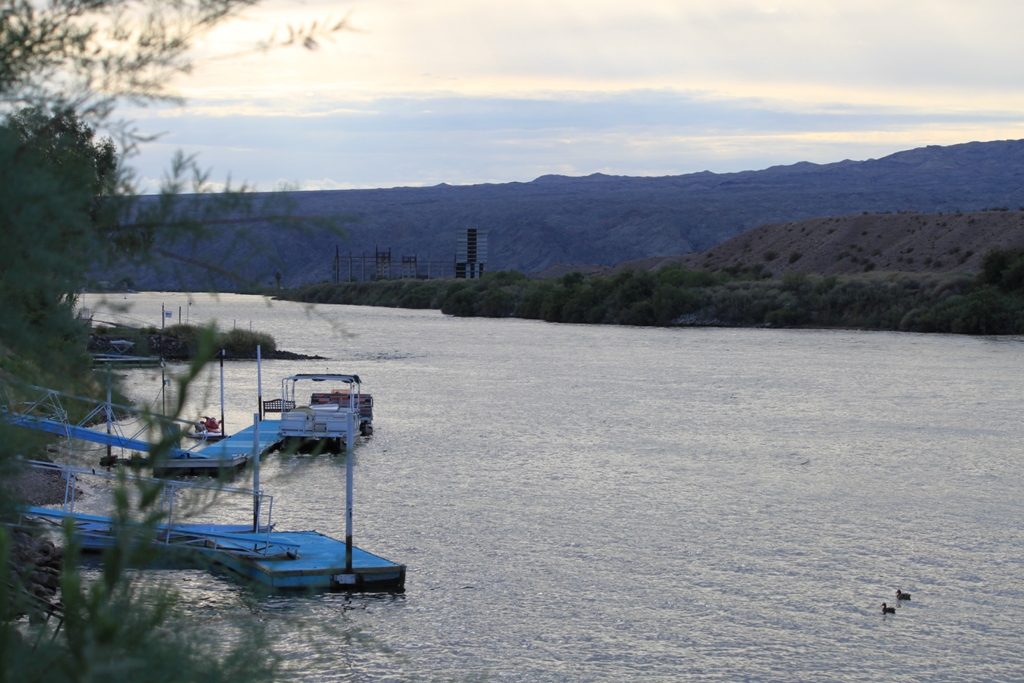Last summer, we took the family out to Laughlin, Nevada, which is located on the Colorado River, south of Las Vegas. Laughlin is a rather small town along the Colorado River in the middle of the desert. Laughlin is in Nevada, so it’s very reason for existence is to be a gambling resort.
The casinos (the tall buildings) run along the river front, which is obscured in the distance. The river defines the state line between Nevada and Arizona. Across the river is Bullhead City, Arizona.
 Laughlin is a town that once had a brighter future than fate would eventually allow, and remnants of that are part of the scenery, like this unfinished casino that sits off in the distance …
Laughlin is a town that once had a brighter future than fate would eventually allow, and remnants of that are part of the scenery, like this unfinished casino that sits off in the distance …
 That unfinished hotel casino is surrounded by a dead golf course, another sign of better days gone by.
That unfinished hotel casino is surrounded by a dead golf course, another sign of better days gone by.
 Now that hotel is on the outskirts of town. Downtown Laughlin, a different story. The casino district in downtown Laughlin is alive and well, and fills up every weekend with tourists.
Now that hotel is on the outskirts of town. Downtown Laughlin, a different story. The casino district in downtown Laughlin is alive and well, and fills up every weekend with tourists.


 During the day, there’s a water taxi you can take to the different casinos at the river’s edge, and the river is alive with boats and jet skiers on the river, and plenty of water activities.
During the day, there’s a water taxi you can take to the different casinos at the river’s edge, and the river is alive with boats and jet skiers on the river, and plenty of water activities.

 Our hotel, us being highly cost-conscious, was actually across the river in Bullhead City. Billed as having river views, the hotel (although it was no resort) was indeed located next to the water. A walk through a dirt lot where a house once was, and down to an abandoned overlook did indeed give you a river view. Despite the less than glamorous surroundings, I enjoyed strolling down to the river often during my stay, which is how I came to observe this man-made hydrological phenomena.
Our hotel, us being highly cost-conscious, was actually across the river in Bullhead City. Billed as having river views, the hotel (although it was no resort) was indeed located next to the water. A walk through a dirt lot where a house once was, and down to an abandoned overlook did indeed give you a river view. Despite the less than glamorous surroundings, I enjoyed strolling down to the river often during my stay, which is how I came to observe this man-made hydrological phenomena.
Now it’s important to note that Laughlin sits right below Davis Dam. Operated by the Bureau of Reclamation, Davis Dam forms Lake Mojave, but it’s real purpose is to regulate releases from Hoover Dam. And to produce hydropower.
 On my first morning stroll down to the dirt lot overlooking the Colorado River, I noticed the boats sitting in the mud at their docks, and just figured it was drought on the Colorado River – we hear about that all the time, right? What a bummer for those who own those boats, I said to myself.
On my first morning stroll down to the dirt lot overlooking the Colorado River, I noticed the boats sitting in the mud at their docks, and just figured it was drought on the Colorado River – we hear about that all the time, right? What a bummer for those who own those boats, I said to myself.
 So imagine my surprise when we return from our time out on the river and I stroll back down to the dirt lot overlooking the river … and all those boats now are in plenty of water!
So imagine my surprise when we return from our time out on the river and I stroll back down to the dirt lot overlooking the river … and all those boats now are in plenty of water!
 I thought it really quite funny, and chuckled about it all weekend long as if it were my own private hydrological joke. It reminded me of when I found the box at Owens Lake with a big switch that said “On” and “Off”. It cracked me up because in a sense it was true – there was no Owens Lake until they turned on the pumps and gizmos that makes the water come out of the emitters and flood over the land to keep the dust down. As it turns out the Colorado River is much the same …
I thought it really quite funny, and chuckled about it all weekend long as if it were my own private hydrological joke. It reminded me of when I found the box at Owens Lake with a big switch that said “On” and “Off”. It cracked me up because in a sense it was true – there was no Owens Lake until they turned on the pumps and gizmos that makes the water come out of the emitters and flood over the land to keep the dust down. As it turns out the Colorado River is much the same …
My guess is that the river gets turned on about the same time people in the West start turning on their air conditioners. Dam operators must have this on a schedule that the residents are all aware of because if you don’t get your boat back in before they turn the river off, you would have a serious problem! So, looking in the other direction, it’s morning and the river is still “OFF” …
 Check out the water line across the river … (river is OFF) I’m guessing at least four feet difference … it’s substantial!
Check out the water line across the river … (river is OFF) I’m guessing at least four feet difference … it’s substantial!



Nice observations about the river’s flow and tying it back into power production requirements into the grid. Here’s how it all works —
Power production into the grid comes from several sources. Thermal (nuke & coal), gas fired, wind, solar and hydro. The bulk of the power comes from the thermal plants as the price of operation is lower. The drawback is that it takes hours for these plants to bring power levels up and back down (think of the time it takes your oven to warm up to use and cool down after you’re done with cooking) Same principle with a thermal plant. Solar produces only during the day, wind power can be intermittent. Gas fired plants cost more but can go online on demand and offline on demand. Hydro, has fast response times like gas fired plants but are more economical to run.
Now, the grid. Power changes can happen rather quickly on a grid as people turn on lights, air conditioners, motors, etc. The thermal plants handle the base load but hydro has the speed to make the dynamic changes needed to stabilise the grid. That is what you saw on the river.
Had you been there longer (after making the association) You would have spotted that the river levels can have several characteristics based on how many generators Davis has online.
Yes, there is more to this equation… Now factor that water releases from Hoover, Davis and Parker supply the needs of downstream water users that needs to show up at the ‘right time’ in the field, Release too much water or too little water from any of these dams and it can be costly.
dg
Hi dg,
Thanks for explaining all of that.
A few years ago, I put together a slideshow presentation on how we generate electricity, so I knew much of that, but was too lazy to explain it 😉 For those of you who are interested, it’s here: Electricity: A Visual Primer:
http://www.slideshare.net/MavensManor/electricity-a-visual-primer-5913813#
It’s interesting to contemplate the differences based on generators. There is so much going on in the water there right on the river, I wonder how much it affects them. Possibly not much.
The next post I need to put up is our trip the next day down Telephone Road to the other side, the Lake Mojave side of the dam. During the day, there’s a nice big beach there. I wonder how the levels fluctuate at that beach at night when they lower the flows … I would imagine, though, it’s probably not nearly as dramatic.
Hi Maven,
My wife and I were at Laughlin over 20 years ago, returning from a Grand Canyon trip. At the time, Davis Dam was open to self-guided tours throughout the inside and top of the structure, including the power house. It was a nice day and I took a lot of b/w photos.
regards,
Bob Rutledge